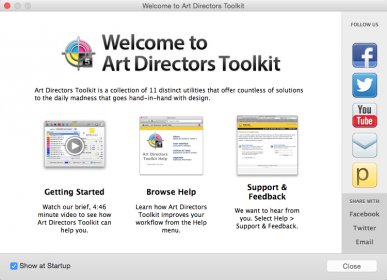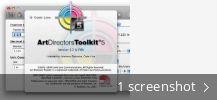Over 2,500 Native Applications & Support for All Popular Digital Devices Now Available
Art Directors Toolkit is designed for creative professionals (graphic and web designers), this stand-alone application is packed with features-Search through thousands of color swatches in. This is a specialized reference tool for both Web and print creative professionals. Art Directors Toolkit (ADT) is the “Designer’s On-screen Toolset” for Artists and Designers working with digital media. Always a one-click-away companion dedicated to speeding up the design process, ADT works almost by stealth whether using Illustrator, Photoshop, InDesign, QuarkXpress, Dreamweaver or any tool to create digital media and websites. The latest version of the application is supported on Mac OS X 10.5 or later. The application is sometimes referred to as 'Art Directors Toolkit 4', 'Art Directors Toolkit 3', 'Art Directors Toolkit 5'. Art Directors Toolkit for Mac lies within Design & Photo Tools, more precisely Viewers & Editors.
Mac OS X version 10.1.2 is available through The Apple Store® (www.apple.com), at Apple’s retail stores and through Apple Authorized Resellers for a suggested retail price of $129(US). The Mac OS X v10.1.2 upgrade package is available for current Mac OS X users through Apple’s Mac OS Up-to-Date program for $19.95(US), which has been extended until January 31, 2002.


Bill Evans
Apple
(408) 974-0610
bevans@apple.com
Edelman Worldwide
(650) 429-2778
taara.hoffman@edelman.com
At 24 Seven we work with a lot of Art Directors. The job requires an extensive skill set that goes beyond graphic design chops. Find out all the details below!
Art Director job description:
Grid Art Toolkit
Art Directors are responsible for unifying the visual expression of a brand or product. The role of an Art Director goes beyond the physical appearance as they think critically about the optimal way to present information to the viewer.
They are usually tasked to create concepts and ideation for various digital and traditional marketing campaigns. A large part of an Art Director’s responsibility is to support marketing teams by bringing ideas to life through creation and execution.
Skills Art Directors need:
As far as actual art and graphic design skills go, Art Directors should be advanced with Mac products, Microsoft Office, and Adobe Creative Suite with emphasis on Photoshop, Illustrator, InDesign, and Bridge says our Director of Full-Time Recruitment, Jesse Kleinow. Typography is also a key component to an Art Director’s skill set and having web design skills is definitely an added bonus.
Art direction also refers to great storytelling. Art Directors should possess the creative ability to tell brand stories that resonate with customers across a variety of industries and mediums. Creative strategy is hugely important according to Jesse. An art Directors skills should go beyond the creative process and they must be able to analyze and optimize campaigns for past, present, and future projects including meeting with stakeholders to understand their needs as well. Because of this Art Directors must be extremely organized with attention to detail.
Art Directors also have to have experience managing a team such, typically of Junior Designers. Jesse adds, managing project timelines through “allocating Designers to the right projects to ensure completion” is imperative.

How to get experience as an Art Director:
One way to get experience as an Art Director is by pursuing a Bachelor’s degree in graphic design or fine arts from a credible institution. In addition, Jesse says having 3-7 years of hands on design experience is necessary. During this time you should have been mentoring Junior Designers, sitting in with Art Directors and Creative Directors on strategy meetings, and working on concepting. Previous experience with directing photo shoots, videos, and omnichannel marketing will also suffice.
What hiring managers look for:
Today most hiring managers look for an online portfolio that shows your distinct visual design skills and experience with rich media. Hiring managers want to know your style can reflect the brand’s DNA through layout, design, and typography.
Key components to success:
Collaboration is a major key to success for Art Directors because they often support other departments within the organization. Jesse says delivering what clients want on time and within budget is another component to being a successful Art Director. At the same time, a stand out Art Director pushes the limits of creativity while staying within brand guidelines.
Art Directors Toolkit For Mac Catalina
Click here to access our free Job Toolkit for everything you need to know about today’s most in-demand jobs.
Additional resources to sharpen your skills:
Looking for a job as an Art Director? Browse our openings today.